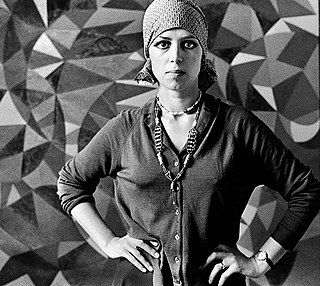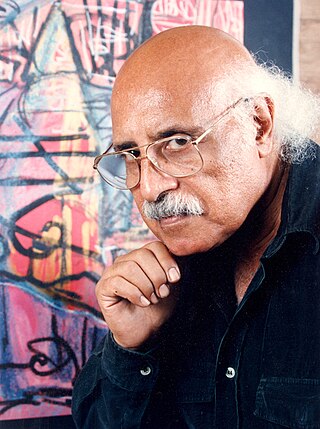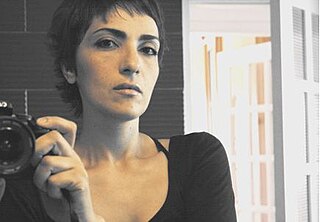Menhat Helmy (1925-2004) was an artist and pioneer in Egyptian etchings and printmaking.
Menhat Helmy (1925-2004) was an artist and pioneer in Egyptian etchings and printmaking.
Menhat Helmy was born in Helwan, Egypt in on July 11, 1925 as the middle child in a family of seven sisters and two brothers. She graduated from Cairo's High Institute of Pedagogic Studies for Art in 1949 before continuing her education abroad at the Slade School of Fine Art between 1953–55, [1] where she focused on drawing, painting, and etching. [2] She later studied coloured graphics at Morley College in London during her second stay in London between 1973-79.
Along with likes of Hussein El Gebaly, Abdullah Gohar, and Mariam A. Aleem, Helmy was part of a pioneering generation of artists who played a pivotal role in the field. [3] Helmy's black-and-white etchings were critically acclaimed for their complexity, as well for their difficulty in realization. Helmy was one of the first artists to engrave entire scenes into her work, replicating the effects of sketches and elaborate drawings on zinc before transforming them into prints.
After winning the Slade Prize of Etching in 1955, Menhat Helmy went on to participate in exhibitions around the world. She took part in most local exhibitions in Egypt from 1956 onwards and held her first private etching exhibition in 1966. [2] She participated in many international biennales of etchings in West Germany, Yugoslavia, Poland, Italy, Tokyo, and India. She won the Saloon Du Caire award in 1959 and 1960, the Cairo Production Exhibition prize in 1957, and the Ljublyana Honorary Prize in 1961. [2] Helmy went on to become a lecturer at the Fine Arts Institute in Cairo, a Professor of Fine Arts at the Helwan University in Cairo, an Honorary Professor of Etching at the Accademia delle Arti del Disegno in Florence, Italy, [4] and a member of the Print Maker Council in the United Kingdom. [2]
While Helmy retired from printmaking in the 1980s due to a lung condition contracted from the chemicals used in her etchings, she continued to teach at Helwan University until her death in 2004 at the age of 78. [2]
Helmy's work is represented in the Museum of Modern Arts in Egypt and is in private collections in Egypt, Germany, Britain, the U.A.E., and the United States. [2] One of her abstract etching, 'To the Point,' was donated to Cairo University by her daughter, Sara Khallaf. Her painting, 'Procession to Work,' was sold at auction house Christies in 2007. [5] Her abstract painting, 'Space Exploration,' was acquired by Sultan Sooud Al-Qassemi of the Barjeel Art Foundation in 2019. [6]
Gazbia Sirry was an Egyptian painter.

Berenice Sydney (1944–1983), born Berenice Frieze, and professionally known as 'Berenice', was a British artist who produced a substantial body of work from 1964 until her death in 1983. Her oeuvre consists of paintings on canvas and paper, drawings, prints, children's books, costume design, and performance. A memorial exhibition of her work was held at the Royal Academy in 1984 followed by solo shows in Italy, Abu Dhabi, Bahrain, Switzerland, and Britain. Her work continues to be featured in print and watercolour shows held in Burlington House. Her work is in over 100 private and public collections.
An artistic project curated by Ahmed Foula in Cairo, 2008.
Peter Clarke was a South African visual artist working across a broad spectrum of media. He was also a writer and poet.

Hussein El Gebaly (Arabic:حسين الجبالي ar:حسين الجبالي) was an Egyptian artist.

George Abdel Masih Al Bahgoury or George Bahgoury is an Egyptian-French artist. An accomplished painter and sculptor, he is most famous as a caricaturist and political cartoonist.
Tahia Mohammed Halim was an Egyptian painter. Tahia Halim was one of the pioneers of the Modern Expressive Movement in Egyptian Art in the 1960s, where she excelled in expressing the Egyptian character’s idiosyncrasies in her works. Many of her works concern the Nubian culture, the Nile, boats, and the popular and national subjects for which she has been granted several honorary awards in Egypt and abroad.

Emil Schumacher was a German painter. He was an important representative of abstract expressionism in post-war Germany.

Yehia Dessouki is an Egyptian painter and visual artist making contemporary art using diverse kinds of media both traditional and digital. He is also an architect, who graduated from the faculty of fine-arts, architecture department, of Helwan University. He has participated in many group exhibitions showing several art works featuring different themes, such as: Architecture of Old Islamic Cairo - Still Life - Lanterns of Ramadan Fawanees - Circus, and later on he made his first solo exhibition about "Joy of Roses" including soft pastel sketches and also oil paintings.

Kamal Amin Awad (1923–1979) was a pioneering Egyptian artist in the field of graphic arts. The artist, whose masterpieces and unique techniques impressed Egyptian modern art, was born in Tanta in 1923. He was interested in teaching his students about the modern techniques applied by schools abroad. However, he was keen to make use of the talents of his ancient forerunners in view of Egypt's rich Pharaonic, Coptic, Islamic and Folk arts. Accordingly, he succeeded in a unique style in his works. The artist's versatility helped him to work as a photographer, a sculptor, and an illustrator. He received the First Class Award of Art and Science in 1974.
Charlotte Hodes, is a British artist.
Kim Lim (1936–1997) was a Singaporean-British sculptor and printmaker of Chinese descent. She is most recognized for her abstract wooden and stone-carved sculptures that explore the relationship between art and nature, and works on paper that developed alongside her sculptural practice. Lim's attention to the minute details of curve, line and surface made her an exponent of minimalism.
Doa Aly is an Egyptian artist.

Mariam A. Aleem was an Egyptian artist and art professor specializing in printed design. She received her Bachelor of Arts from the Faculty of Fine Arts Cairo in 1954 and her Master of Fine Arts in graphic printing 1957 from the University of Southern California. Beginning in 1958, Aleem taught printmaking at the Faculty of Fine Arts in Alexandria. In 1968 she became an assistant professor, heading the Printmaking Department. Aleem became a full professor in 1975 and led the Design Department from 1985 to 1990. She earned her Ph.D. in the history of art from Helwan University in Cairo. Aleem exhibited worldwide, with shows in the United States, Lebanon, Egypt, Germany, Italy, and Norway.
Ala Younis is a research-based artist and curator, based in Amman. Younis initiates journeys in archives and narratives, and reinterprets collective experiences that have collapsed into personal ones. Through research, she builds collections of objects, images, information, narratives, and notes on why/how people tell their stories. Her practice is based on found material, and on creating materials when they cannot be found or when they do not exist.

Amal Kenawy was an Egyptian contemporary visual artist, best known for her videos, performance and feminist work. Active since 1998, her successful career helped her gain international recognition.
Sabah Naim is a contemporary Egyptian multimedia artist. Her work focuses on documenting people and scenes in Cairo, Egypt, and incorporates street photography, painting, collage, embroidery, and video art.

The Egyptian pavilion is a national pavilion of the Venice Biennale. It houses Egypt's official representation during the Biennale. The building is part of a complex that Brenno Del Giudice designed in 1932 to house Venetian decorative arts on Sant'Elena Island—an expansion of the Biennale from its main Giardini area. The building later served as Switzerland's national pavilion before the country moved to a new pavilion in 1952 and left the building to Egypt. The national pavilions for Serbia and Venice flank the Egyptian pavilion. Egypt's 1995 exhibition won the Biennale's Golden Lion award for best national pavilion.
Amy Nimr (1898–1974), also known as Amy Smart, was an Egyptian-born artist, writer and patron of the arts. She is known for her association with the Cairo-based Art and Liberty Group.
Zeinab Abd al-Hamid was an Egyptian artist known for her colour saturated paintings of Egyptian cities. Abd al-Hamid used an array of media, from watercolours to oils. While art historians struggled to place her works in a single art movement, the general consensus is that her paintings are part of the Egyptian modernist movement.